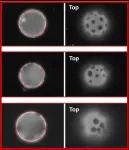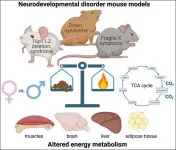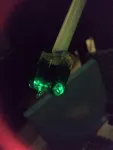(Press-News.org) Researchers from North Carolina State University have developed an exosome-coated stent with a "smart-release" trigger that could both prevent reopened blood vessels from narrowing and deliver regenerative stem cell-derived therapy to blood-starved, or ischemic, tissue.
Angioplasty - a procedure that opens blocked arteries - often involves placing a metal stent to reinforce arterial walls and prevent them from collapsing once the blockage is removed. However, the stent's placement usually causes some injury to the blood vessel wall, which stimulates smooth muscle cells to proliferate and migrate to the site in an attempt to repair the injury. The result is restenosis: a re-narrowing of the blood vessel previously opened by angioplasty.
"The inflammatory response that stents cause can decrease their benefit," says Ke Cheng, corresponding author of the research. "Ideally, if we could stop smooth muscle cells from over-reacting and proliferating, but recruit endothelial cells to cover the stent, it would mitigate the inflammatory response and prevent restenosis." Cheng is the Randall B. Terry Jr. Distinguished Professor in Regenerative Medicine at NC State and a professor in the NC State/UNC-Chapel Hill Joint Department of Biomedical Engineering.
There are drug-eluting stents currently in use coated with drugs that discourage cell proliferation, but these anti-proliferative drugs also delay stent coverage by endothelial cells - which are the cells healthcare providers want to coat the stent.
To solve this problem, Cheng and his team developed a stent coating composed of exosomes derived from mesenchymal stem cells. Exosomes are tiny nano-sized sacs secreted by most cell types. The idea behind the coating was two-fold: first, since the exosomes are composed of materials not much different from cell membranes they 'camouflage' the stent to trick smooth muscle cells and the body's immune system. Second, the exosomes promote coverage of the stent by endothelial cells and, in the case of injury, travel downstream to the site to promote tissue repair.
To prevent premature depletion of the therapy, the stent releases exosomes when it encounters reactive oxygen species (ROS) - which are more prevalent during an inflammatory response.
"Think of it as a smart release function for the exosomes," Cheng says. "Ischemic reperfusion injuries, which occur when blood flow is diminished and then reestablished, create a lot of ROS. Let's say the heart is damaged by ischemia. The enhanced ROS will trigger the release of the exosomes on the stent, and regenerative therapy will travel through the blood vessel to the site of the injury."
The research team performed in vitro testing to ensure biocompatibility and test the release mechanism. They found that in the presence of ROS, the exosomes released up to 60% of their secretions within 48 hours post-injury.
In a rat model of ischemic injury, the researchers compared their exosome-eluting stent (EES) to both a bare metal stent (BMS) and a drug-eluting stent (DES). They found that in comparison to the BMS, their stent performed better in both decreasing stenosis and promoting endothelial coverage. While the DES performed similarly to the EES in preventing restenosis, the EES was less injurious to the vessel wall and had better endothelial coverage overall. In addition, the exosomes released from EES promoted muscle regeneration in rats with hind limb ischemia. The researchers plan to test the stent in a large animal model with an eye toward eventual clinical trials.
"This bioactive stent promotes vascular healing and ischemic repair, and a patient wouldn't need additional procedures for regenerative therapy after the stent is in place," Cheng says. "The stent is the perfect carrier for exosomes, and the exosomes make the stent safer and more potent in tissue repair."
INFORMATION:
The research appears in Nature Biomedical Engineering and was supported by the National Institutes of Health and the American Heart Association. NC State postdoctoral research scholars Shiqi Hu and Zhenhua Li are co-first authors.
-peake-
Note to editors: An abstract follows.
"Exosome-eluting stents for vascular healing after ischaemic injury"
DOI: 10.1038/s41551-021-00705-0
Authors: Shiqi Hu, Zhenhua Li, Deliang Shen, Dashuai Zhu, Ke Huang, Teng Su, Phuong-Uyen Dinh, Jhon Cores, Ke Cheng, North Carolina State University
Published: April 5, 2021 in Nature Biomedical Engineering
Abstract:
Drug-eluting stents implanted after ischaemic injury reduce the proliferation of endothelial cells and vascular smooth muscle cells and thus neointimal hyperplasia. However, the eluted drug also slows down the re-endothelialization process, delays arterial healing and can increase the risk of late restenosis. Here we show that stents releasing exosomes derived from mesenchymal stem cells in the presence of reactive oxygen species enhance vascular healing in rats with renal ischaemia-reperfusion injury, promoting endothelial cell tube formation and proliferation, and impairing the migration of smooth muscle cells. Compared with drug-eluting stents and bare-metal stents, the exosome-coated stents accelerated re-endothelialization and decreased in-stent restenosis 28 days after implantation. We also show that exosome-eluting stents implanted in the abdominal aorta of rats with unilateral hindlimb ischaemia regulated macrophage polarization, reduced local vascular and systemic inflammation, and promoted muscle tissue repair.
ITHACA, N.Y. - The cost of harvesting solar energy has dropped so much in recent years that it's giving traditional energy sources a run for their money. However, the challenges of energy storage - which require the capacity to bank an intermittent and seasonally variable supply of solar energy - have kept the technology from being economically competitive.
Cornell University researchers led by Lynden Archer, Dean and Professor of Engineering, have been exploring the use of low-cost materials to create rechargeable batteries that will make energy storage more ...
AMHERST, Mass. - A team of polymer science and engineering researchers at the University of Massachusetts Amherst has demonstrated for the first time that the positions of tiny, flat, solid objects integrated in nanometrically thin membranes - resembling those of biological cells - can be controlled by mechanically varying the elastic forces in the membrane itself. This research milestone is a significant step toward the goal of creating ultrathin flexible materials that self-organize and respond immediately to mechanical force.
The team has discovered that rigid solid plates in biomimetic fluid membranes experience interactions ...
Mouse models of neurodevelopmental disorders possess unique, sex-specific metabolic dysfunctions, according to a new study in eNeuro. Understanding the unique metabolic effects of each disorder in both animal models and humans may lead to more personalized treatments and diagnostic methods.
Any disorder affecting the brain also impacts the body. People with neurodevelopmental disorders -- including Down syndrome and autism spectrum disorders -- are at increased risk for developing diabetes, obesity, and hypertension. Yet the impact of these three disorders on metabolism has not been studied.
Menzies et al. measured the resting energy metabolism of three neurodevelopmental disorder mouse models: Down syndrome, ...
A new report by AARP Pennsylvania and Drexel University's College of Nursing and Health Professions highlights how geographic, racial/ethnic and economic factors are combining to restrict access to health care services for many Pennsylvanians, creating disparities that have become more pronounced during the COVID-19 pandemic.
"Disrupting Disparities in Pennsylvania: Retooling for Geographic, Racial and Ethnic Growth" shows that health inequities are most acute among those living in rural and low resourced areas of the state, and among underrepresented populations (particularly Black/African American and Latino), who lack access to health care, experience digital divide and face persistent ...
In an effort to save her beloved animals, Kathy Janson, a Maine Coon cat enthusiast reached out to a University of Cincinnati researcher to find a way to help her pets who were developing heart troubles.
Maine Coon cats are known as great mousers, popular farm cats and, of course, for their enormous size. The New England breed is a really big cat and can weigh up to 19 pounds and grow up to 40 inches in length. Janson fell in love with these animals more than 25 years ago bringing them into her Cincinnati suburban home to become part of her family.
"Maine ...
Researchers from the University of Minnesota Twin Cities College of Science and Engineering and Medical School have developed a unique head-mounted mini-microscope device that allows them to image complex brain functions of freely moving mice in real time over a period of more than 300 days.
The device, known as the mini-MScope, offers an important new tool for studying how neural activity from multiple regions of the outer part of the brain, called the cortex, contribute to behavior, cognition and perception. The groundbreaking study provides new insight into fundamental research that could improve human brain conditions such as concussions, autism, Alzheimer's, and Parkinson's disease, as well as better understanding ...
A study at the University of Chicago Medicine found U.S. women experienced increased incidence of health-related socioeconomic risks (HRSRs), such as food insecurity and interpersonal violence, early in the COVID-19 pandemic. This was associated with "alarmingly high rates" of mental health problems, including depression and anxiety. The research was published April 5 in the Journal of Women's Health.
Other studies have found evidence for higher rates of anxiety and depression and related issues, such as alcohol overuse, connected to the pandemic -- but this study is the first to link early pandemic-related changes in HRSRs to mental health effects ...
Researchers at the National Institute of Standards and Technology (NIST) and collaborators have demonstrated an atom-based sensor that can determine the direction of an incoming radio signal, another key part for a potential atomic communications system that could be smaller and work better in noisy environments than conventional technology.
NIST researchers previously demonstrated that the same atom-based sensors can receive commonly used communications signals. The capability to measure a signal's "angle of arrival" helps ensure the accuracy of radar and wireless communications, ...
RIVERSIDE, Calif. -- A team led by a biomedical scientist at the University of California, Riverside, has developed a new RNA-sequencing method-- "Panoramic RNA Display by Overcoming RNA Modification Aborted Sequencing," or PANDORA-seq -- that can help discover numerous modified small RNAs that were previously undetectable.
RNA plays a central role in decoding the genetic information in DNA to sustain an organism's life. It is generally known as the intermediate molecule used to synthesize proteins from DNA. Cells are full of RNA molecules in complex and diverse forms, two main types ...
Although stratospheric ozone protects us by filtering out the sun's ultraviolet radiation, tropospheric ozone is a harmful pollutant. A new study has shown that ozone in the lower layers of the atmosphere decreases crop yields in maize and changes the types of chemicals that are found inside the leaves.
Ozone is formed when nitrous oxide, released from industries and tail pipes of cars, is broken down by sunlight and chemically reacts to form ozone. Researchers at the University of Illinois Urbana-Champaign have been studying the effects of ozone pollution on crops for over 20 years at a unique facility where crops can be grown under real-world farm ...





